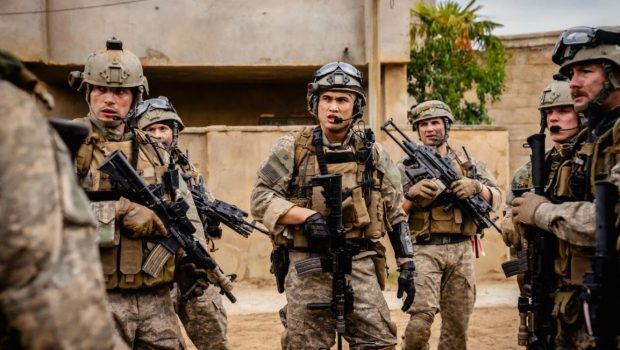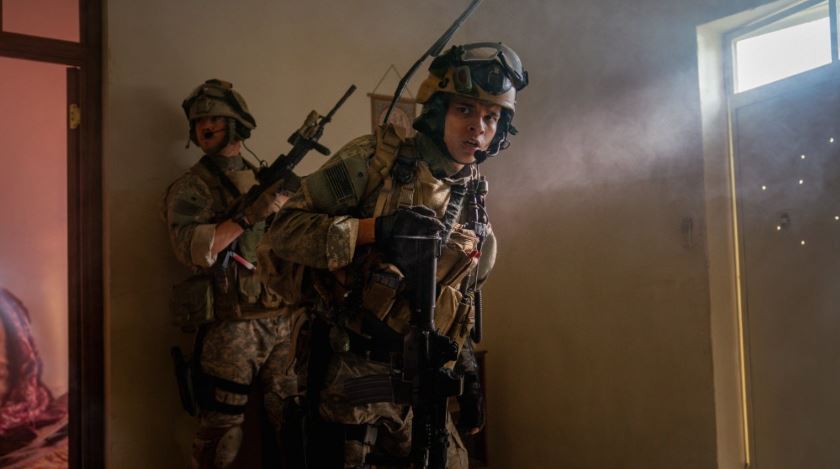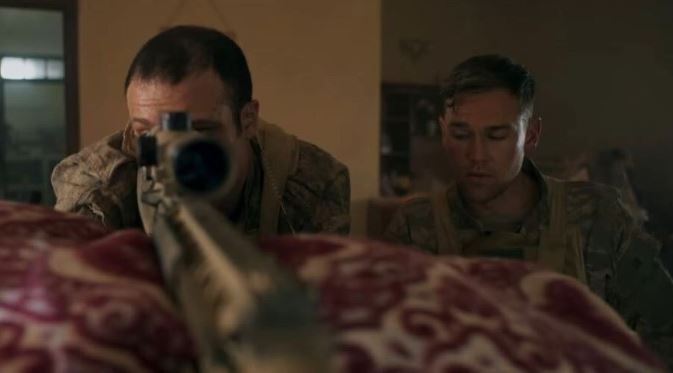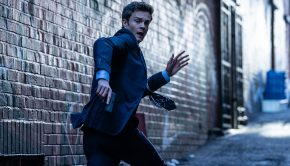Warfare – Film Review
Reviewed by Damien Straker on the 12th of April 2025
Nixco presents a film by Alex Garland and Ray Mendoza and
Written by Alex Garland and Ray Mendoza
Produced by Andrew Macdonald, Allon Reich, Matthew Penry-Davey, and Peter Rice
Starring D’Pharaoh Woon-A-Tai, Will Poulter, Cosmo Jarvis, Kit Connor, Finn Bennett, Taylor John Smith, Michael Gandolfini, Adain Bradley, Noah Centineo, Evan Holtzman, Henry Zaga, Joseph Quinn, and Charles Melton
Cinematography David J. Thompson
Edited by Fin Oates
Rating: TBA
Running Time: 95 minutes
Release Date: the 17th of April 2025
Warfare should have been the definitive anti-war film of our time. Instead, it is a tense, realistic technical exercise but without the thematic depths of Alex Garland’s previous films. He co-directed and co-wrote this film with former US Navy SEAL Ray Mendoza. The marketing around Warfare is that it is based on Mendoza’s memories of combat. Though in truth he’s made a career as an advisor on action films and even the video game Call of Duty: Modern Warfare (2019). He and Garland depict this film’s conflict without movie cliches and outright jingoism. However, the intensity of the gunfire, bloodshed, and teamwork from US soldiers dissipates the characters. Constricting the story to one siege forgoes bigger, more interesting questions about war’s futility. While you appreciate Garland’s skills in constructing traumatic action scenes, you wish Warfare was more challenging than its title. It should have marked a personal and political transition for grunts who were maimed during one of the most pointless modern conflicts.
As mentioned, this entire 95-minute film is focused on one siege battle in Ramadi, Iraq. It’s 2006 and an early image we see is a laneway in front of a block of houses. US soldiers silently begin to fill the frame as they drift into formation. Some of these soldiers are played by actors Will Poulter, Noah Centineo, and Michael Gandolfini. One troop scales the fence and then unlocks the gate, allowing the team to quickly pour in and take the building! They move through the floors and then break down a concrete wall with a sledgehammer. It is odd after silently infiltrating to be loudly knocking down walls like a home renovation show but never mind. During the daytime they use the building as an outpost and monitor the street. Their sniper spends an age reviewing suspicious activity and raises his concerns about a possible threat. The real danger occurs first when a grenade erupts and then when a US vehicle is destroyed, leaving several troops injured. A serious leg wound means the squad must work together to aid one of its own. While under gunfire it makes it particularly difficult to move the wounded and then have them safely extracted.
The early scenes are the most interesting in thematic and formal construction. In the first scene we see a hypersexualised exercise video playing out. The camera then reveals that it is being excitedly watched by whooping US soldiers that will feature throughout the film. Though in reality the material shown before combat is probably far more explicit. The idea is that the troops are pumped up before entering the warzone. However, the excitement is then tempered with the slow-burning anticipation of the sniper scope scenes. We see how much concentration and awareness this task takes and the physical constraints of extensively lying prone. Alex Garland and Ray Mendoza are juxtaposing the different emotions and tempos of warfare. It’s the feeling of jubilance amongst the team before receding to the slow-burning anticipation of combat after the exuberance fades. The idea of observing combat was also strongly explored in Civil War (2024) where a wartime journalist objectively watched the battlefield. This is why Warfare’s early scenes resonate as they tease a similar through-line.
The film stumbles after trading interpersonal qualities for its traumatic barrage. There is no doubting the film’s technical prowess, particularly its tense soundscape. Warfare’s sound and images rumble as aircraft bombards the neighbourhood, smashing dust and dirt across the screen. The assault weapons are nearly as oppressive and loud as they were in Civil War as the US troops exchange fire with the insurgents. Meanwhile, the screams from the wounded soldiers are toe-curling and appropriately realistic. Admittedly, there is also a powerful scene involving administering morphine that lingers. However, the trauma is as oppressive as the gunfire itself. If it were not for the actors, the soldiers would be indistinguishable. We don’t learn anything about them before deployment. The characterisation is razor thin too because their dialogue includes barking orders, sharing coordinates, and scrambling to survive. There are two Iraqi translators and a local family present, but they have no agency. While there might not be any cheesy Michael Bay-type moments, the focus on US troops means the perspective isn’t subverted. Garland will say his subtractions reinforce authenticity. However, realism is the last bastion for beret-wearing directors unwilling to concede that story fundamentals make great cinema. Without a protagonist, Garland cannot probe beyond the combat. It is a missed opportunity since he has equipped his other films with fascinating ideas about autonomy.
This film is understandably a tribute to the troops who were brave, cruelly injured, and then saved by their friends. One would suggest this traumatic incident is another reason to add greater character depth so we know the personal stakes. The damage endured could have fielded larger ideas about this terrible war. Enough time has passed to remind people about its blatant lies. A filmmaker like Alex Garland should also have the temerity to make an outright anti-war film! Questions of autonomy and freewill were prevalent in Garland’s Ex Machina (2014), which is still one of his best films. Civil War at least framed its objectivity around a journalist’s emotional distance from war. There is only one belated shot in Warfare hinting at the conflict’s futility. While technically commendable and proof of Garland’s ability to construct highly realistic and involving scenes of physical trauma, he doesn’t delve deeper than a bloody and traumatic snapshot of US soldiers we never come to know or what they hope to achieve. Once the credits declare the troops always answer the call, you half expect Garland, Mendoza, and the cast to march on screen and start singing: “Who’s the leader of the club that’s made for you and me? M-I-C-K-E-Y, M-O-U-S-E! Forever let us hold our banner high! High! High! High!”
Summary: While technically commendable and proof of Garland’s ability to construct highly realistic and involving scenes of physical trauma, he doesn’t delve deeper than a bloody and traumatic snapshot of US soldiers we never come to know or what they hope to achieve.










